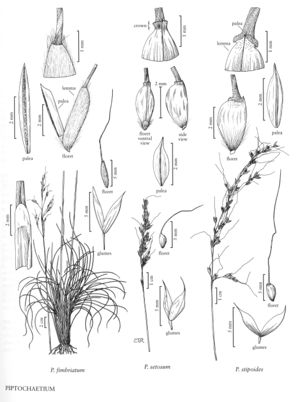Plants perennial; cespitose, not rhizomatous. Culms 4-150 cm, usually erect, sometimes decumbent, glabrous, not branched above the base; basal branching intravaginal; prophylls shorter than the sheaths, mostly glabrous, keels usually with hairs, apices bifid, teeth 1-3 mm; cleistogenes not developed. Sheaths open to the base, margins glabrous; ligules membranous, decurrent, truncate to acute, sometimes highest at the sides, sometimes ciliate; blades convolute to flat, translucent between the veins, often sinuous distally. Inflorescences terminal panicles, open or contracted, spikelets usually confined to the distal 1/2 of each branch. Spikelets 4-22 mm, with 1 floret; rachillas not prolonged beyond the base of the floret; disarticulation above the glumes, beneath the floret. Glumes subequal, longer than the floret, lanceolate, 3-7 (8) -veined; florets globose to fusiform, terete to laterally compressed; calluses well developed, sharp or blunt, glabrous or antrorsely strigose, hairs yellow to golden brown; lemmas coriaceous to indurate, glabrous or pubescent, striate, particularly near the base, smooth, papillose, or tuberculate, often smooth on the lower portion and papillate to tuberculate distally, margins involute, fitting into the grooved palea, apices fused into a crown, awned, lemmas often narrowed below the crown, crowns usually ciliate; awns caducous to persistent, usually twice-geniculate, first 2 segments usually twisted and hispid, terminal segment straight and scabridulous; paleas longer than the lemmas, similar in texture, glabrous, sulcate between the veins, apices prow-tipped; lodicules 2 or 3, membranous, glabrous, blunt or acute; anthers 3; ovaries glabrous; styles 2. Caryopses terete to globose or lens-shaped, x = 11.
Distribution
Del., D.C, W.Va., Fla., N.J., N.Mex., Conn., Mass., R.I., La., Tenn., N.C., S.C., Pa., N.Y., Va., Ont., Calif., Ala., Mo., Ark., Ga., Ind., Okla., Ariz., Md., Tex., Ohio, Mich., Miss., Ky.
Discussion
Piptochaetium is primarily South American, being particularly abundant in Argentina. It has 27 species. Four species are native in the Flora region; two South American species are established at a single location in Marin County, California.
All stipoid species with elongate florets were included in Stipa by Hitchcock (1935, 1951) and other North American taxonomists. Parodi (1944) argued that Piptochaetium should be expanded to include those species of Stipa with elongated florets that shared with Piptochaetium its distinctive lemma and palea morphology, hair color, and leaf anatomy. His interpretation is now universally accepted.
The basal chromosome number of Piptochaetium is probably 11. This interpretation implies that counts of In = 42 (Gould 1965 and Reeder 1968 for P. fimbriatum; Reeder 1977 for P. pringlei) represent an aneuploid reduction from 2n = 44. It is also possible that the base number is 7, as is common in the Pooideae.
Selected References
Lower Taxa
Key
| 1 | Florets 6.5-22 mm long; culms 40-130 cm tall. | > 2 |
| 2 | Lemmas hairy; awns 19-35 mm long | Piptochaetium pringlei |
| 2 | Lemmas glabrous; awns 40-120 mm long. | > 3 |
| 3 | Florets 7-13 mm long; awns 40-75 mm long | Piptochaetium avenaceum |
| 3 | Florets 13.5-22 mm long; awns 62-120 mm long | Piptochaetium avenacioides |
| 1 | Florets 2.3-5.5 mm long; culms 20-95 cm tall. | > 2 |
| 4 | Lemmas golden brown, hairy, the hairs easily rubbed off | Piptochaetium fimbriatum |
| 4 | Lemmas dark brown, glabrous. | > 5 |
| 5 | Awns 10-16 mm long; blades 0.8-1.5 mm wide; distal margin of the lemma crowns straight | Piptochaetium setosum |
| 5 | Awns 15-25 mm long; blades 0.2-0.4 mm wide; distal margin of the lemma crowns sometimes slightly to strongly revolute | Piptochaetium stipoides |
"decumbent" is not a number."prolonged" is not a number.

